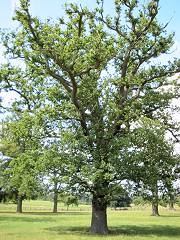Tools and Resources
We use some essential cookies to make this website work.
We’d like to set additional cookies to understand how you use forestresearch.gov.uk, remember your settings and improve our services.
We also use cookies set by other sites to help us deliver content from their services.
 1920s
1920sDuring the early 1920s acute dieback of mature woodland oak first aroused widespread concern in England. Damage was thought to begin with the defoliation of trees in early summer by caterpillars of the oak leaf roller moth (Tortrix viridana), an insect which was very abundant in the years after the end of World War 1.
By 1924 there were reports of oaks were dying in alarming numbers in certain sections of the defoliated woods. However, just a year later many of the sickly oaks showed an improvement in condition, and this improvement coincided with a marked reduction in the moth.
By the late 1920s, there were no further reports of oak dieback for over 30 years.
In 1958 death of young pedunculate oak occurred in several woods near the Norfolk coast, but adjacent sessile oak was unaffected. Drought and exposure were thought to be important triggers of decline, together with the effects of defoliating insects and mildew.
There were also accounts of damage in the early 1980s in Surrey and in the Forest of Dean.
However, it was not until around 1989 that another episode of serious oak decline started to have an impact over a 3- to 4-year period. Trees reported to be most affected were in the Midlands and southern England and ranged from 40 to 200 years of age. Approximately half were in woodland and half were in parkland, but the majority of the trees were pedunculate oak. At some of the affected sites up to a quarter of the trees had dieback symptoms or died from oak decline.
Cookies are files saved on your phone, tablet or computer when you visit a website.
We use cookies to store information about how you use the dwi.gov.uk website, such as the pages you visit.
Find out more about cookies on forestresearch.gov.uk
We use 3 types of cookie. You can choose which cookies you're happy for us to use.
These essential cookies do things like remember your progress through a form. They always need to be on.
We use Google Analytics to measure how you use the website so we can improve it based on user needs. Google Analytics sets cookies that store anonymised information about: how you got to the site the pages you visit on forestresearch.gov.uk and how long you spend on each page what you click on while you're visiting the site
Some forestresearch.gov.uk pages may contain content from other sites, like YouTube or Flickr, which may set their own cookies. These sites are sometimes called ‘third party’ services. This tells us how many people are seeing the content and whether it’s useful.